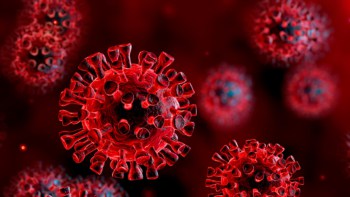
Tap, tap, tap… Swish, swish… Tap, tap… Whoooo… Silence.
The Korotkoff sounds heard through a stethoscope are routine in non-invasive clinical blood pressure measurement. For over a century since the sounds were discovered, however, scientists have debated what causes them. Are there cavitation bubbles in the brachial artery? A “water hammer” type phenomenon? Most posited theories looked toward a source of sound inside the arteries and related to blood flow.
But perhaps Korotkoff sounds aren’t sounds at all.
That’s according to scientists at the Institute Physics for Medicine Paris. In a recent study detailed in Science Advances, postdoctoral researcher Jérôme Baranger and his colleagues in Mickael Tanter’s group found that Korotkoff sounds may not be a sound wave at all, but a vibration of the arterial walls that transmits into surrounding tissues, a bit like a seismic wave.
“Our main finding was that Korotkoff sounds are not sounds, which is kind of funny,” says Baranger.
The researchers used ultrafast ultrasound to image Korotkoff sound generation. Ultrasound is like a digital camera that uses sound waves instead of light to take pictures. Ultrafast ultrasound takes these pictures at high frame rates – thousands of images per second – allowing researchers to see transient phenomena happening inside the body in real time.
When analysing their data, which was acquired from 15 healthy volunteers, and applying the results of physical modelling, Baranger found that Korotkoff sounds are paradoxically not sound waves emerging from the brachial artery, but rather shear vibrations conveyed in surrounding tissues. The shear vibrations were correlated and comparable in intensity with Korotkoff sounds.
“I remember the first time I opened our data set, and I saw this huge wave propagating into tissue around the artery,” says Baranger. “I thought ‘what is this?’, because I used to see arteries with a pulse wave propagating in the walls, but it was very subtle. Here, we could see the whole tissue dancing around the artery. And it seemed to correlate with what we could hear in the stethoscope. I was really excited – it was completely unexpected.”
Arterial motions are usually smaller than a millimetre, but displacements of the brachial artery – which can exceed five millimetres – are readily visible on ultrasound. As a blood pressure cuff inflates and presses on the brachial artery, the artery softens. When the heart contracts, the instantaneous increase in blood pressure propagates through the arteries in a pulse wave. When the wave reaches the softened portion of the brachial artery, it slows down and distends the soft arterial walls, making them vibrate, and as the pulse wave propagates under the cuff, it gradually transforms into a shock wave.
Vibrations of the artery transmit to surrounding muscles in the form of a shear wave, like an earthquake. When this earthquake reaches the arm’s surface and the stethoscope, it causes the stethoscope to vibrate, which produces the Korotkoff sounds.

“In previous studies, there was no chance to think about this possible mechanism as a shear wave, or a seismic wave, into tissues, because they were either resolved in space or time, so we were always missing one of the two dimensions. I think the technology of ultrafast ultrasound enabled us for the first time to study this problem with a very good resolution, both in space and time,” says Baranger. “I hope our alternative theory will stand, because we directly observe the quality of sound.”

Ultrafast ultrasound maps tiny blood vessels deep in the human brain
While the research group’s study suggests a plausible physical mechanism of Korotkoff sounds, they are hesitant to claim causality until they confirm their results in a larger study and compare the physical phenomenon measured with ultrafast ultrasound with invasive blood pressure measurements. Understanding this mechanism could ultimately improve blood pressure measurements and provide additional understanding of arterial mechanical properties.
“We want to get a deeper understanding of the physical phenomenon being observed – spectral properties of the wave are changing with propagation, which carries a lot of information about the mechanical properties of the arteries,” Baranger says. “We hope that by knowing the phenomenon we could maybe have a better way of defining diastolic blood pressure, not only based on the way you perceive it, hear it, in your ear, but maybe based on a physical measurement.”



